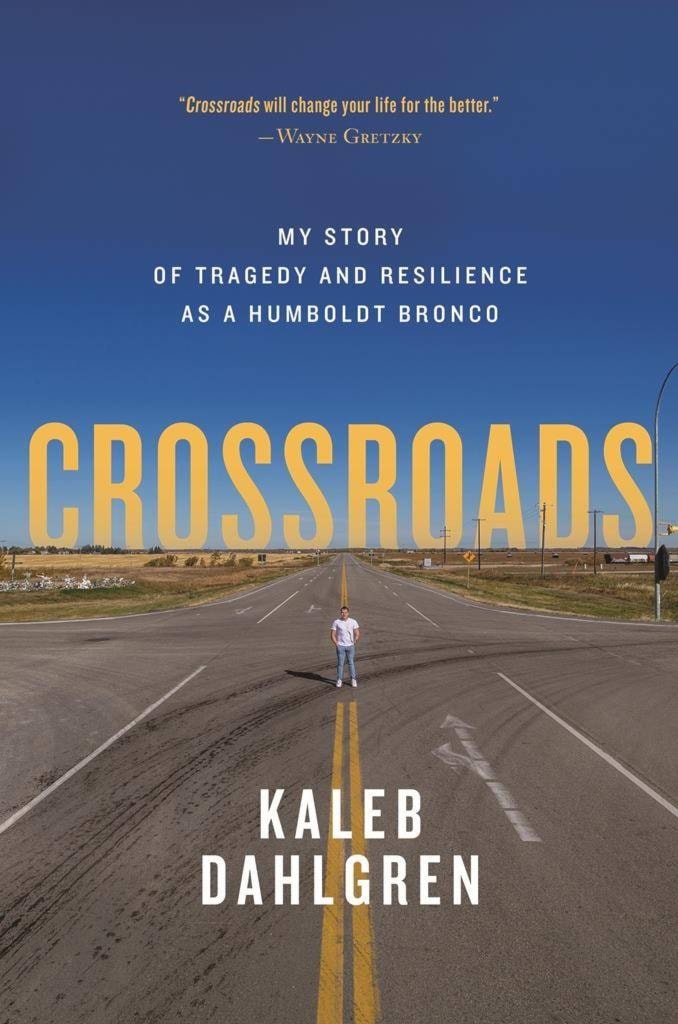Even before he was seriously injured in the Humboldt Broncos bus crash as a 20-year-old, Kaleb Dahlgren had already faced his share of adversity.
He was diagnosed with Type 1 diabetes at the age of four. As a young hockey player, he grieved the deaths of a teammate in a car accident and a strength coach to cancer. And, at 16, he nearly lost his dad to a serious illness.
Bดฮิชนูอ๘อ๘ึทIt really put things in perspective in my life,Bดฮิชนูอ๘อ๘ึท Dahlgren said in a recent interview from his home in Saskatoon.
Bดฮิชนูอ๘อ๘ึทWe really donBดฮิชนูอ๘อ๘ึทt know how long we have.Bดฮิชนูอ๘อ๘ึท
Dahlgren, now 23, was one of 13 players injured on April 6, 2018, when his junior hockey teamBดฮิชนูอ๘อ๘ึทs bus and a semi-trailer collided in rural Saskatchewan. Sixteen people Bดฮิชนูอ๘อ๘ึท including 10 players Bดฮิชนูอ๘อ๘ึท were killed.
He tells his story with the help of a ghost writer in the book Bดฮิชนูอ๘อ๘ึทCrossroads,Bดฮิชนูอ๘อ๘ึท which was released Tuesday.
The crash nearly three years ago left Dahlgren with a traumatic brain injury, neck and nerve damage, a fractured back and multiple other injuries.
He still canBดฮิชนูอ๘อ๘ึทt remember anything from the crash. He woke up in hospital four days later.
Despite his lack of memory, Dahlgren said he tried to be open and honest in the book about who he is as a person.
Bดฮิชนูอ๘อ๘ึทIt was super difficult to do it in the first place, but I also find thereBดฮิชนูอ๘อ๘ึทs a lot of strength in being vulnerable,Bดฮิชนูอ๘อ๘ึท he said. Bดฮิชนูอ๘อ๘ึทThe writing process was super hard for me.
Bดฮิชนูอ๘อ๘ึทOne of the harder parts was Chapter 16. That chapter was super, super emotional.Bดฮิชนูอ๘อ๘ึท
In that chapter, Dahlgren writes about each of the 16 people who died.
Bดฮิชนูอ๘อ๘ึทWe were all a team. We were one,Bดฮิชนูอ๘อ๘ึท he writes.
He recalled team broadcaster Tyler BieberBดฮิชนูอ๘อ๘ึทs Bดฮิชนูอ๘อ๘ึทvoice of the BroncosBดฮิชนูอ๘อ๘ึท and Dayna Brons being there for everyone as the teamBดฮิชนูอ๘อ๘ึทs athletic therapist. He wrote about how assistant coach Mark Cross was like a big brother and how team captain Logan Schatz had the biggest personality in the dressing room.
Although Dahlgren said it was difficult to write about his friends on the bus, it was also Bดฮิชนูอ๘อ๘ึทcathartic in my healing journey.Bดฮิชนูอ๘อ๘ึท
He said it helped him to think about the people heBดฮิชนูอ๘อ๘ึทs had in his life Bดฮิชนูอ๘อ๘ึท particularly his parents, coaches and teammates Bดฮิชนูอ๘อ๘ึท and how theyBดฮิชนูอ๘อ๘ึทve helped him become the person he is today.
Bดฮิชนูอ๘อ๘ึทI was able to reflect on that throughout this process,Bดฮิชนูอ๘อ๘ึท he said. Bดฮิชนูอ๘อ๘ึทIt was also cathartic to finally put some thoughts to paper and, in a way, set the Broncos stuff down and move forward in my life.Bดฮิชนูอ๘อ๘ึท
Dahlgren said he will always carry the weight of the crash with him, just as he will always have a brain injury and visible scars.
HeBดฮิชนูอ๘อ๘ึทs still not cleared to play contact hockey, but he had been practising and working out with his team at York University in Toronto before COVID-19 hit.
Bดฮิชนูอ๘อ๘ึทIBดฮิชนูอ๘อ๘ึทm really lucky to even be able to be in that situation in the first place,Bดฮิชนูอ๘อ๘ึท he said. His brain scans showed he had 10 spots where he had suffered a bleed, which made the doctors wonder why his physical injuries werenBดฮิชนูอ๘อ๘ึทt a lot worse.
Bดฮิชนูอ๘อ๘ึทIBดฮิชนูอ๘อ๘ึทm coined a miracle.Bดฮิชนูอ๘อ๘ึท
He is finishing a commerce degree at York and has applied to a couple of other schools to continue his studies and become a chiropractor.
Dahlgren is also an ambassador for the Juvenile Diabetes Research Foundation and set up the DahlgrenBดฮิชนูอ๘อ๘ึทs Diabeauties program to mentor diabetic children as a way to help others.
He said he has similar reasons for writing the book.
Bดฮิชนูอ๘อ๘ึทI didnBดฮิชนูอ๘อ๘ึทt want to write a book unless it gave back to others.Bดฮิชนูอ๘อ๘ึท
He would like it to generate awareness about hope and resilience, and is donating some of the proceeds to STARS, a non-profit that uses helicopters as air ambulances across the Prairies.
Bดฮิชนูอ๘อ๘ึทThey save lives every day and they saved lives on April 6th, too,Bดฮิชนูอ๘อ๘ึท he said.
READ MORE:
Colette Derworiz, The Canadian Press
Like us on and follow us on .
Want to support local journalism during the pandemic? Make a donation



